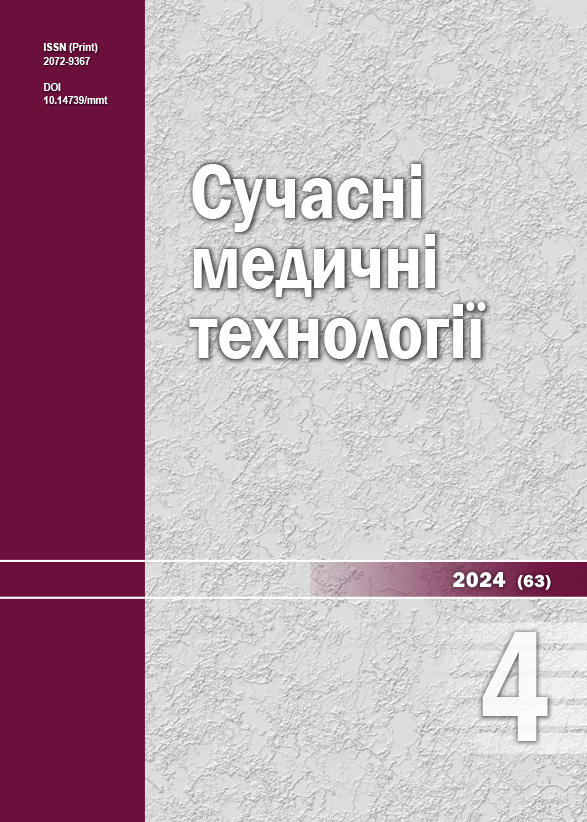Multiple acute complications of transarterial chemoembolization of liver metastases
DOI:
https://doi.org/10.14739/mmt.2024.4.313384Keywords:
pancreatic cancer, liver, metastases, transarterial chemoembolizationAbstract
The aim of the work: to describe a clinical case of treatment of multiple acute complications after transarterial chemoembolization of liver metastases in a patient with pancreatic cancer.
Materials and methods. Patient M., 52 years old, sought medical help at the “DIEVO” Medical Center for Surgical Solutions. He had previously been treated for pancreatic cancer in other medical institutions.The patient’s anamnestic data, features of his previous treatment, including transarterial chemoembolization of liver metastases, were studied. The patient underwent a clinical examination, laboratory and instrumental studies, as a result of which multiple acute complications were diagnosed. The council of specialists made a decision to optimize the treatment tactics.
Results. On the 24th day after hospitalization, the patient, after completing treatment at the medical center, was discharged from the clinic in a satisfactory condition for further outpatient treatment and observation by an oncologist at his place of residence. For timely diagnosis of purulent-septic complications after transarterial chemoembolization of liver metastases, in addition to ultrasound, computer, magnetic resonance imaging, careful clinical monitoring of the patient and a comprehensive assessment of his health are required.
Conclusions. Careful clinical observation of the patient, comprehensive laboratory and instrumental examination of the patient with ultrasound, computer, magnetic resonance imaging, etc. are important prerequisites for timely diagnosis of possible purulent and septic complications after transarterial chemoembolization of liver metastases.
References
Vincent A, Herman J, Schulick R, Hruban RH, Goggins M. Pancreatic cancer. Lancet. 2011;378(9791):607-20. doi: https://doi.org/10.1016/S0140-6736(10)62307-0
Bondar HV, Shevchenko AI, Halaichuk II, editors. [Oncology]. 2nd ed. Kyiv: VSV "Medytsyna"; 2019. Ukrainian.
Fiore F, Del Prete M, Franco R, Marotta V, Ramundo V, Marciello F, et al. Transarterial embolization (TAE) is equally effective and slightly safer than transarterial chemoembolization (TACE) to manage liver metastases in neuroendocrine tumors. Endocrine. 2014;47(1):177-82. doi: https://doi.org/10.1007/s12020-013-0130-9
Maire F, Lombard-Bohas C, O'Toole D, Vullierme MP, Rebours V, Couvelard A, et al. Hepatic arterial embolization versus chemoembolization in the treatment of liver metastases from well-differentiated midgut endocrine tumors: a prospective randomized study. Neuroendocrinology. 2012;96(4):294-300. doi: https://doi.org/10.1159/000336941
Engelman ES, Leon-Ferre R, Naraev BG, Sharma N, Sun S, O'Dorisio TM, et al. Comparison of transarterial liver-directed therapies for low-grade metastatic neuroendocrine tumors in a single institution. Pancreas. 2014 Mar;43(2):219-25. doi: https://doi.org/10.1097/MPA.0000000000000030
de Baere T, Deschamps F, Tselikas L, Ducreux M, Planchard D, Pearson E, et al. GEP-NETS update: Interventional radiology: role in the treatment of liver metastases from GEP-NETs. Eur J Endocrinol. 2015 Apr;172(4):R151-66. doi: https://doi.org/10.1530/EJE-14-0630
Downloads
Additional Files
Published
How to Cite
Issue
Section
License
The work is provided under the terms of the Public Offer and of Creative Commons Attribution-NonCommercial 4.0 International (CC BY-NC 4.0). This license allows an unlimited number of persons to reproduce and share the Licensed Material in all media and formats. Any use of the Licensed Material shall contain an identification of its Creator(s) and must be for non-commercial purposes only.














